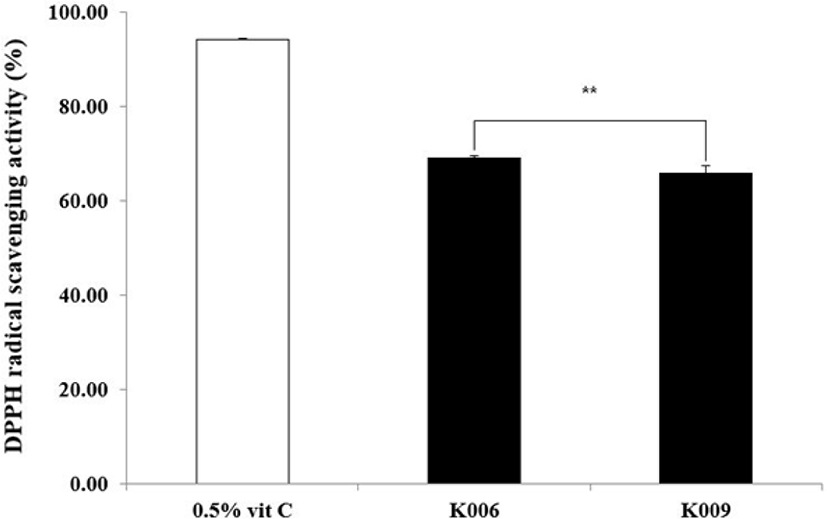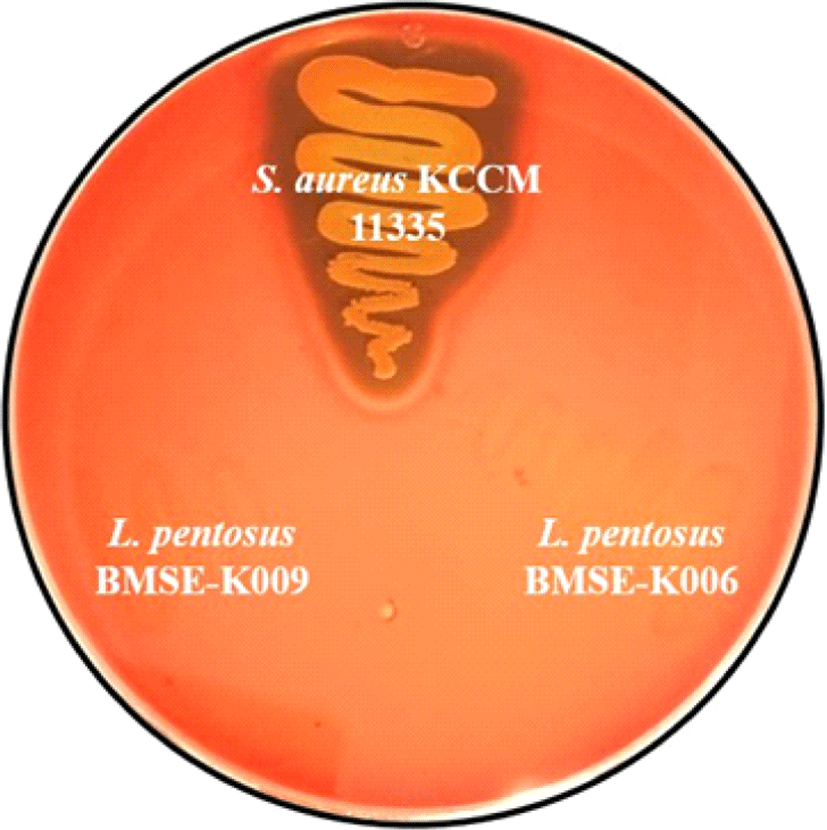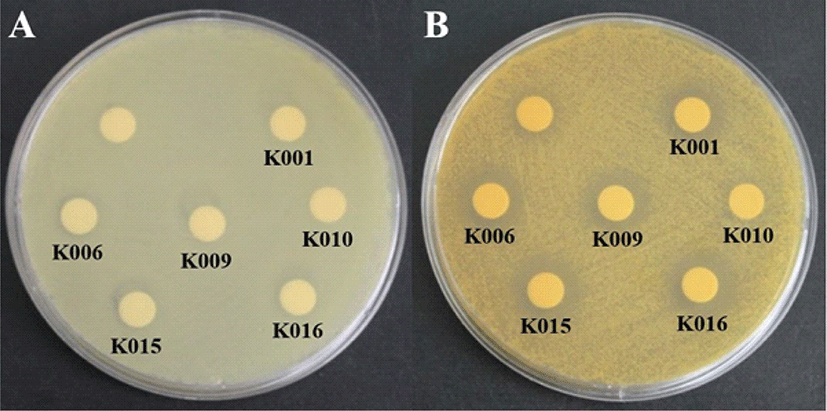Ⅰ. 서 론
케피어 (kefir)는 다양한 박테리아, 효모 등이 함유된 kefir grain을 우유에서 발효시켜 얻어지며, 전 세계 여러 지역에서 생산되는 전통 acidic-alcoholic 발효유로 알려져 있다 (Prado et al., 2015; Rosa et al., 2017; Slattery et al., 2019). 일반적으로 kefir grain에는 108 CFU/g의 lactic acid bacteria (LAB), 106-107 CFU/g의 yeast, 105 CFU/g의 acetic acid bacteria가 존재하며, LAB 중 호모발효 (homofermentative) 및 이종발효 (heterofermentative) 종인 Lactobacillus (Lb), Lactococcus (Lc), Leuconostoc (Le) spp.이 가장 많이 발견된다 (Garrote et al., 2010). 최근 케피어에서 분리된 유산균으로는 Lc. lactis, Le. mesenteroides, Lb kefiri, Lb sunkii (Han et al., 2018), Lb. harbinensis, Lb. paracase, Lb. plantarum (Talib et al., 2019), Lb. kefiranofaciens (Sun et al., 2019), Lb. plantarum (Dinamaraca et al., 2020), Lb. pentosus (You et al., 2020) 등이 있으며, 이에 대한 다양한 효능이 연구되었다.
케피어에서 분리되는 미생물총은 원산지, 배양조건, 저장 및 가공 과정에 크게 의존하며(Garrote et al., 2010; Bengoa et al., 2018), 케피어의 영양성분 또한 우유의 성분, 곡물의 미생물 조성, 발효시간 및 온도, 보관조건에 따라 달라진다 (Rosa et al., 2017). 케피어는 대장암 (Khoury et al., 2014), 호르몬 의존성 유방암 (de Moreno de LeBlanc and Perdigon, 2010), 성인 백혈병 (Maalouf et al., 2011), 피부암 (Nagira et al., 2002) 등에 대한 효과가 입증되었고, 케피어 내 유산균 또한 면역 및 종양세포에 대한 효과 (Yamane et al., 2018), 항균, 항산화, 항알레르기 및 종양억제 (Slattery et al., 2019) 등 다양한 효과가 보고된 바 있다.
따라서 케피어는 안전하고 잠재적으로 유익한 균주의 저장소 역할을 할 뿐만 아니라(Bengoa et al., 2018) 케피어 곡물 및 케피어 내 미생물총은 다양하고 잠재적인 이점이 있어 건강상의 이점을 위한 유제품 생산에 유용할 수 있음을 나타낸다 (Zheng et al., 2013). 이에 본 연구에서는 케피어 유래 유용 유산균을 분리하여 분리 균주의 생화학적 특성과 항균활성 및 항산화 효능을 확인하여 유용 유산균 자원으로써 기초자료를 마련하고자 하였다.
Ⅱ. 재료 및 방법
중국 현지 가정에서 수집한 kefir 시료 3개를 멸균튜브에 채취하여 4℃에서 보관 후, 신선도 유지를 위해 5일 이내 조건 하에 유산균을 분리하였다. Kefir 시료와 0.85% NaCl을 1:9 (v/v)수준에서 연속적으로 희석한 후, 최종 농도가 10-8이 되도록 희석하였다. 희석액을 100 μL 취하여 유산균 감별배지인 Bromo Cresol Purple (BCP) plate count agar (EIKEN chemical, Tokyo, Japan)에 획선도말하여 30℃에서 24시간 배양하였고, 노란색 환을 형성한 콜로니를 취해 Lactobacilli MRS broth (Difco Co., Sparks, MD, USA)에서 이를 순수 분리하였다. 항균활성이 우수한 균주의 선별을 위해 Escherichia coli KCTC 2571 및 Staphylococcus aureus KCTC 3881에 대한 disk diffusion 항균활성 측정을 통해, 항균력이 확인된 균주를 1차 선별하였으며, 선별된 균주의 16s rRNA 염기서열을 분석하여 최종 동정하였다 (BIOFACT Co., Daejeon, Korea). 염기서열 분석을 위해 518F (CCAGCAGCCGCGGTAATACG)와 805R (GACTACCAGGGTATCTAATC) primer와 CLUSTAL_X (Clustal W and Clustal X version 2.0. Bioinformatics)를 사용하였으며 분석한 염기서열은 GenBank database 및 EzTaxon-e server에서 비교 분석하였다. 분리 균주의 생화학적 특성 분석에는 API CHL kit (BioMérieux, Craponne, France), API ZYM kit (BioMérieux, Craponne, France)를 이용하여 당이용성 및 효소 활성 정도를 확인하였다.
항균활성 측정에 사용된 지시균주는 Staphylococcus spp., Escherichia spp. 및 Pseudomonas spp., Candida albicans의 총 8주를 사용하였다 (Table 1). 지시균주는 각각 Tryptone Soy Broth (Difco), Luria-Bertani broth (Difco), Yeast Malt broth (Difco)에 2% (v/v) 수준인 2.5×107 CFU/mL를 접종하여 37℃에서 18시간 배양하였으며, 배양 후 최종 지시균주의 균수를 106 CFU/mL로 조정하여 실험에 사용하였다. 항균활성 측정은 disk diffusion 방법에 의하여 확인하였으며, clear zone의 크기가 15 mm 이상이면 +++, 10-15 mm는 ++, 10 mm 미만일 경우 +로 판별하였다. 유산균을 MRS broth에 2% (v/v) 접종하여 30℃에서 24시간 배양한 후 5분간 원심분리(13,000×g)하여 상등액을 취해 0.2 ㎛ membrane filter (SM13P020SL, Hyundai micro Co., Seoul, Korea)로 여과한 것을 시료로 사용하였다.
유산균 배양액의 DPPH radical 소거능은 Blois (1958)의 방법을 참고하여 측정하였다. 대조군으로 0.5% (w/v) vitamin C를 사용하였으며, 100% ethanol에 용해시킨 0.2 mM DPPH solution 500 μL에 배양액 60 μL를 혼합 후 30분간 암반응 하였다. 이후 UV/VIS-spectrophotometer (BioTek, Vermont, USA)를 이용하여 520 nm에서 O.D.를 측정하였다. 소거능 값은 배양액 첨가군 (A)과 배양액을 첨가하지 않은 blank군 (A0)간의 흡광도 비 (%)로 나타내었다.
분리 균주의 용혈성을 확인하기 위해 blood agar base (Kisan Bio Co., Seoul, Korea)에 5% defibrinated sheep blood (Kisan Bio)를 첨가한 blood agar plate에 분리 균주와 대조군인 S. aureus KCCM 11335를 획선 도말하여 37℃에서 48시간 배양한 후, Argyri 등 (2013)의 방법에 따라 용혈성을 확인하였다.
Ⅲ. 결과 및 고찰
Kefir로부터 유용 유산균을 분리하기 위해 중국 현지 가정에서 kefir 시료를 수집하여 6주의 유산균을 분리하였으며, 이후 항균력이 우수한 균주를 선별하기 위해 E. coli KCTC 2571 및 S. aureus KCTC 3881에 대한 항균활성을 확인하였다 (Fig. 1). 지시균주에서 모두 항균력이 우수한 K006과 K009를 선별하여 16s rRNA 유전자 염기서열 분석 결과, 분리 균주 BMSE-K006, K009는 Lactobacillus pentosus DSM 20314와 모두 99.86%의 상동성을 보였다 (data not shown). 이후 분리 균주의 생화학적 특성을 확인하기 위하여 API CHL kit와 API ZYM kit를 이용하여 당이용성 및 효소활성을 분석하였다. API 50 CHL kit를 이용하여 분리 균주의 당이용성을 확인한 결과, D-galactose, D-glucose, D-fructose, mannitol, sorbitol, lactose, inulin 등 29개의 탄소원에서 양성반응을 보였다 (Table 2). BMSE-K006과 K009의 당이용성 패턴은 유사하였으나 BMSE-K009는 K006보다 이당류인 melibiose의 추가적인 이용이 확인되었다. API ZYM kit를 이용한 분리 균주의 효소활성을 확인한 결과, BMSE-K006과 K009는 leucin arylamidase, valine arylamidase, β-glucosidase, N-acetyl-β-glucosaminidase에서 모두 양성반응을 보였다 (Table 3).
Bae 등 (2006)의 연구에서 분리한 L. pentosus CU13, L. pentosus CU05와 비교하였을 때, 본 연구에서 분리한 L. pentosus BMSE-K006과 K009의 당이용성 패턴과 유사하였다. 또한 Marroki 등 (2011)이 산양유에서 분리한 L. pentosus LbMS40, L. pentosus LbMT9, L. pentosus LbMT10과 비교하였을 때, BMSE-K006과 K009의 glycerol에 대한 이용성은 확인되지 않았으나, L. pentosus LbMS40, L. pentosus LbMT9, L. pentosus LbMT10보다 L-sorbose, amygdalin의 추가적인 당이용성이 확인되었으며, 본 연구에서 분리한 L. pentosus BMSE-K006과 K009는 D-galactose와 lactose의 이용성이 확인되어 우유 또는 유제품 등의 당이용 가능성을 확인할 수 있었다.
분리 균주 L. pentosus BMSE-K006과 K009의 병원성 박테리아에 대한 항균력을 측정한 결과, Staphylococcus spp., Escherichia spp. 및 Pseudomonas aeruginosa에서 모두 우수한 항균력이 확인되었으며, Candida albicans 2주에 대한 항진균 효과는 나타나지 않았다 (Table 4).
Kim 등 (2016)은 발효시간에 따른 kefir와 함께 lactic acid (pH 3.5)와 acetic acid (pH 3.5) 및 ethyl alcohol (2%) 용액의 항균효과를 비교하였는데, S. aureus, Enterococcus faecalis, E. coli, P. aeruginosa에서 모두 발효된 kefir에서만 항균효과가 나타나, kefir의 낮은 pH에 의한 항균효과가 아닌 kefir 내 다양한 대사산물을 포함하는 항균물질에 기인할 수 있음을 보고하였다. 한편 Chifiriuc 등 (2011)은 Bacillus subtilis, E. faecalis, Salmonella enteritidis, S. aureus, E. coli에 대한 kefir의 우수한 항균효과와 kefir 내 항균물질을 생산하는 복합적인 probiotics에 의한 넓은 항균 스펙트럼 활성을 나타냄을 보고하였으며, P. aeruginosa에 대한 kefir의 항균효과가 나타나지 않았으나, 본 연구에서 분리한 L. pentosus BMSE-K006과 K009는 P. aeruginosa에 대한 우수한 항균효과가 나타나, kefir 내 미생물에 의한 항균효과가 나타남을 유추할 수 있었다. 또한 L. pentosus TV35b가 생산하는 pentocin TV35b(Okkers et al., 1999), L. pentosus CS2가 생산하는 pentocin MQ1 (Wayah and Philip, 2018), L. pentosus가 생산하는 박테리오신인 lacidophilin (Zhu and Zhang, 2020) 등 L. pentosus가 생산하는 박테리오신에 대한 연구를 통해 우수한 항균효과가 보고되었으며, 최근 Dai 등 (2021)은 L. pentosus가 생산하는 bacteriocin을 정제하여 그람 양성균과 그람 음성균에 대한 광범위한 항균 활성을 입증한 바 있다. 따라서 본 연구에서 분리한 L. pentosus BMSE-K006과 K009의 그람 양성균 및 그람 음성균에 대한 우수한 항균효과는 유산균이 생산하는 대사산물 중 특정 항균물질에 의한 것으로 추측할 수 있으며, 향후 항균 화합물과 작용기전을 규명하기 위한 추가적인 연구가 수행되어야 할 것으로 판단된다.
1,1-diphenyl-2-picrylhydrazyl (DPPH)는 ethanol 내에서 흡광도 (517 nm)를 갖는 안정적인 free radical로 항산화 물질과 같은 양성자 공여 물질을 만나면 free radical이 제거되어 흡광도가 감소된다 (Abubark et al., 2012). 대표적인 항산화제인 vitamin C를 대조군으로 하여 분리 균주 배양액의 DPPH radical 소거능을 측정하여 유산균 배양액의 항산화 효과를 확인하고자 하였다. DPPH radical 소거능의 결과는 Fig. 2에 제시한 바와 같다. 대조군 0.5% vitamin C의 경우 94.12±0.28%, L. pentosus BMSE-K006과 K009는 각각 69.02±0.53%, 65.88±1.65%로 K006의 소거능이 더 높게 나타났다(p<0.05).

Abo-Saif와 Sakr (2020)이 분리한 L. pentosus 14FE와 L. pentosus 68FE의 DPPH radical 소거능은 각각 54.50%, 61.67%로 보고되었으며, 최근 Unban 등 (2021)이 L. pentosus 3주 배양액의 DPPH radical 소거능을 확인한 결과, 모두 70% 이상으로 보고한 바 있다. 분리 균주의 DPPH radical 소거능과 비교하였을 때, 본 연구에서 분리한 L. pentosus BMSE-K006과 K009의 DPPH radical 소거능과 유사하거나 더 우수하여 분리 균주는 산화적 스트레스를 방지할 수 있는 잠재적인 유용 유산균으로 가치가 있을 것으로 생각된다.
Lactobacillus 35종 중 L. pentosus, L. plantarum 및 L. acidophilus 등은 독성인자 및 전이 가능한 항생제 내성 유전자가 없을 경우 프로바이오틱스로 사용될 수 있다 (Montoro et al., 2016). 그러나 일부 유산균 균주는 잠재적인 병원성을 가질 수 있는 것으로 보고된 바 있어 용혈성 유무, 항생제 내성, 독소 생성 유무, 대사적 특성 등의 확인이 필요하다 (Cannon et al., 2005).
따라서 분리 균주의 용혈성 유무를 확인하기 위해 S. aureus KCCM 11335를 대조군으로 하여, L. pentosus BMSE-K006과 K009의 용혈성을 확인하였다 (Fig. 3). 그 결과, 분리 균주에서는 용혈성이 관찰되지 않아 안전성을 뒷받침할 수 있으며, 추후 probiotics의 특성 확인을 포함하여 항생제 내성 등의 안전성 확인에 대한 입증이 필요할 것으로 생각된다.

Ⅳ. 요 약
본 연구에서는 박테리아, 효모 등의 복합체가 존재하고 유익한 균주의 저장소 역할을 하는 케피어 (kefir)로부터 유용 유산균을 분리하고자 하였다. 항균활성이 우수한 케피어 유래 유산균 2주의 16s rRNA 염기서열 분석 결과, BMSE-K006과 K009는 Lactobacillus pentosus DSM 20314와 모두 99.86%의 상동성을 보였다. L. pentosus BMSE-K006과 K009 두 균주의 당이용성 패턴은 유사하였으며, D-galactose와 lactose의 이용성이 확인되어 우유 또는 유제품 등의 당이용 가능성을 확인하였다. 또한 Staphylococcus spp., Escherichia spp. 및 Pseudomonas aeruginosa 등 병원성 박테리아에 대한 L. pentosus BMSE-K006과 K009의 항균활성을 확인한 결과, 지시균주에서 모두 우수한 항균력을 보였다. 그러나 Candida albicans 2주에 대한 항진균 효과는 나타나지 않았다. L. pentosus BMSE-K006과 K009 배양액은 각각 69.02%, 65.88%의 우수한 DPPH radical 소거능을 보였으며, 용혈성 유무를 확인한 결과, 두 균주 모두 용혈성은 관찰되지 않았다. 본 연구에서는 케피어 유래 유산균 L. pentosus BMSE-K006과 K009의 병원성 박테리아에 대한 우수한 항균효과 및 항산화 효과가 입증되어 유용 유산균 자원의 가능성을 뒷받침할 기초자료가 될 수 있을 것으로 판단된다.







